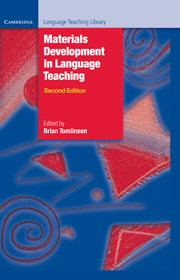Book contents
- Frontmatter
- Contents
- Preface
- Glossary of basic terms for materials development in language teaching
- Acknowledgements
- 1 Introduction: principles and procedures of materials development
- Part A Data collection and materials development
- 2 Using corpora in the language classroom
- 3 Concordances in the classroom without a computer: assembling and exploiting concordances of common words
- 4 Telling tails: grammar, the spoken language and materials development
- Comments on Part A
- Part B The process of materials writing
- 5 A framework for materials writing
- 6 Writing course materials for the world: a great compromise
- 7 How writers write: testimony from authors
- Comments on Part B
- Part C The process of materials evaluation
- 8 The analysis of language teaching materials: inside the Trojan Horse
- 9 Macro- and micro-evaluations of task-based teaching
- 10 What do teachers really want from coursebooks?
- 11 The process of evaluation: a publisher’s view
- Comments on Part C
- Part D The electronic delivery of materials
- 12 Developing language-learning materials with technology
- 13 New technologies to support language learning
- Comments on Part D
- Part E Ideas for materials development
- 14 Seeing what they mean: helping L2 readers to visualise
- 15 Squaring the circle – reconciling materials as constraint with materials as empowerment
- 16 Lozanov and the teaching text
- 17 Access-self materials
- Comments on Part E
- Conclusions
- Recommended reading
- Index
2 - Using corpora in the language classroom
Published online by Cambridge University Press: 09 February 2023
- Frontmatter
- Contents
- Preface
- Glossary of basic terms for materials development in language teaching
- Acknowledgements
- 1 Introduction: principles and procedures of materials development
- Part A Data collection and materials development
- 2 Using corpora in the language classroom
- 3 Concordances in the classroom without a computer: assembling and exploiting concordances of common words
- 4 Telling tails: grammar, the spoken language and materials development
- Comments on Part A
- Part B The process of materials writing
- 5 A framework for materials writing
- 6 Writing course materials for the world: a great compromise
- 7 How writers write: testimony from authors
- Comments on Part B
- Part C The process of materials evaluation
- 8 The analysis of language teaching materials: inside the Trojan Horse
- 9 Macro- and micro-evaluations of task-based teaching
- 10 What do teachers really want from coursebooks?
- 11 The process of evaluation: a publisher’s view
- Comments on Part C
- Part D The electronic delivery of materials
- 12 Developing language-learning materials with technology
- 13 New technologies to support language learning
- Comments on Part D
- Part E Ideas for materials development
- 14 Seeing what they mean: helping L2 readers to visualise
- 15 Squaring the circle – reconciling materials as constraint with materials as empowerment
- 16 Lozanov and the teaching text
- 17 Access-self materials
- Comments on Part E
- Conclusions
- Recommended reading
- Index
Summary
Introduction
Since the mid 1990s, dictionaries based on corpora (collections of naturally occurring texts) have been widespread in English as a second language (ESL) classrooms. These dictionaries, based on large collections of natural language, not only provide learners with information about word meanings, but also provide important information about word use. As a natural extension of using dictionaries based on corpora, teachers have become increasingly interested in using information from corpora to inform and create language-learning materials. In the 1990s resources such as Johns (1994) and Tribble and Jones (1997) provided teachers with some ideas and guidelines for ways to use corpus information in the classroom. Now, with more and more corpus-informed or corpus-based teaching resources becoming available (such as: Focus on Vocabulary (Schmitt and Schmitt 2005); the Touchstone series (McCarthy, McCarten and Sandiford 2006/2006); and Real Grammar (Conrad and Biber 2009)), this interest has continued to grow and has even expanded to teachers themselves wanting to bring corpora into language classrooms. Using corpora in the language classroom can provide teachers and students with several advantages. Corpora can provide a rich source of authentic material, and, therefore, examples of the language students will encounter outside the language classroom. Corpora can also provide students with many examples of the target feature (e.g. a vocabulary item or grammatical structure) in a concentrated manner, to help them better understand the feature and its contexts and cotexts of use.
Before discussing some ways to bring corpora into a classroom, a word about corpora and corpus linguistics is in order. A corpus is a collection of naturally occurring texts that is usually stored on a computer (see Biber, Conrad and Reppen 1998 for more on the characteristics of corpora). If the texts are stored on a computer, it is possible to search texts for particular features. A number of tools are available for searching corpora (e.g. AntConc, MonoConc, WordSmith – see the Appendix for more information). It is also important to note that the term ‘text’ is used to refer to either spoken or written discourse. The spoken texts are usually transcribed into a written version, and in most cases the audio files are not available.
- Type
- Chapter
- Information
- Materials Development in Language Teaching , pp. 35 - 50Publisher: Cambridge University PressPrint publication year: 2011
- 15
- Cited by



